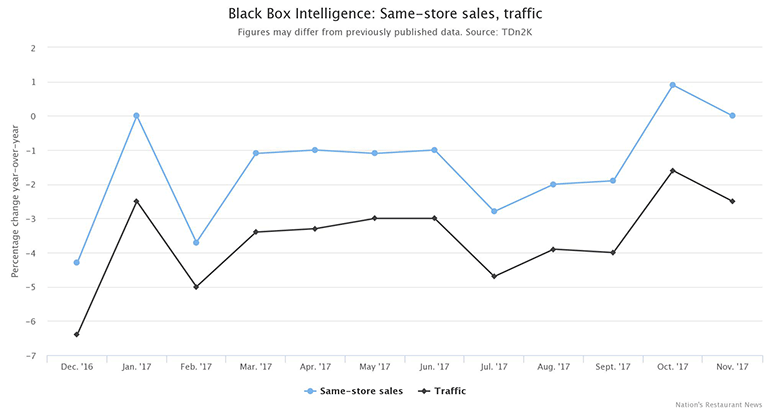This exclusive series to Nation's Restaurant News provides insight into the sales and traffic data from clients subscribing to Black Box Intelligence, a financial performance benchmarking company. The views expressed here do not necessarily reflect those of Nation's Restaurant News.
The industry’s positive sales momentum continued into November as restaurants slowly recover from disappointing third-quarter results.
Same-store sales remained flat year over year during the month. While not on par with October’s 0.9-percent sales growth, November was considerably better than the average 1.6-percent sales decline over the first nine months of the year. Operators and observers are cautiously optimistic that the industry is beginning to show signs of strength after struggling for almost two years.

These insights come from TDn2K data through The Restaurant Industry Snapshot, based on weekly sales from 30,000 restaurant units and more than 170 brands, representing over $68 billion in annual revenue.
“Our concern is that these improved trends come despite the fact that the industry has not cracked the code on declining guest visits,” said Victor Fernandez, executive director of insights and knowledge for TDn2K. “Brands have come to rely on rising checks to overcome the steady loss of traffic.”
Same-store traffic dipped 2.5 percent in November, a 0.9-percentage-point drop from October. It’s been almost three years since restaurants experienced a month of positive guest counts.
Economy picks up steam
While hurricanes impacted areas in the short term, they’ve also resulted in a rebuilding period.
“Job gains are strong, though wage increases continue to lag,” said Joel Naroff, president of Naroff Economic Advisors and TDn2K economist. “Consumers’ confidence is high and, as a result, they are willing to cut into savings in order to maintain their standard of living. While that is supporting growth now, it could create spending issues next year.”
As for the tax bill, its impact on the industry could be varied.
“Lower- and lower-middle-income households benefit modestly, middle income households a little more and upper income households a lot,” he said. “Thus, additional spending on eating out will depend upon the income level of the restaurant’s clientele. It should not be assumed that all restaurant chains will benefit significantly from the tax cuts.”
Check growth accelerates
Despite many brands focusing on price promotions to drive sales and traffic, average check growth has accelerated in recent months.
The average check was up 2.4 percent in November and 2.5 percent in October. Both figures are higher than the 2-percent growth during the first nine months of the year.
“Higher check average increases are risky in a market with steadily decreasing traffic, but brands may be using price to support margins as they face rising labor and operating costs,” Fernandez said.
Counter-service dominates market-share battle
The continued pace of new unit openings adds to market saturation that almost certainly dampens same-store sales growth. While same-store sales have suffered, total industry sales have grown almost 3 percent in 2016 and the first three quarters of 2017.
As total sales rise, the portion of those sales devoted to counter-service brands is also increasing. Based on TDn2K’s Black Box Intelligence research encompassing a sample of over 125,000 restaurant locations, over 70 percent of all dollars spent at restaurant chains in the first three quarters of 2017 have gone to quick-service or fast-casual brands.
These segments are not only large, but they’re also the fastest growing. Quick service in particular had a significant increase in market share during the third quarter. Consumers seem to be reacting positively to the value strategies of the segment’s leading brands. The gains in quick service and fast casual are coming primarily at the expense of casual dining.
Management turnover remains a major headache
TDn2K research over the last year has shown that customer perception of service is a key differentiator between top- and bottom-performing restaurants. Unsurprisingly, turnover, especially at the manager level, is strongly linked with customer service scores.
Hourly employee turnover is stabilizing after years of rising, and even dropped slightly in October. But it still remains at the highest levels in over 10 years. Perhaps the biggest challenge operators face continues to be retaining management. According to TDn2K People Report data, turnover for management positions is at historically high levels and continued to rise in October.
What to expect in the fourth quarter
The strong state of the economy and higher consumer confidence could be positive for December.
“Sales for the first two months of the quarter are up marginally (0.4 percent),” Fernandez said. “We expect that visits to brick-and-mortar retailers will again influence restaurant sales during the busy holiday season. But if current trends continue, it will mark the first quarterly sales increase for the industry in two years.”
TDn2K (Transforming Data into Knowledge) is the parent company of People Report, Black Box Intelligence and White Box Social Intelligence. People Report provides service-sector human capital and workforce analytics for its members on a monthly basis. Black Box Intelligence provides weekly financial and market-level data for the restaurant industry. White Box Social Intelligence delivers consumer insights and reveals online brand health. TDn2K membership represents 43,000 restaurant units, 2.5 million employees and $68 billion in sales. TDn2K also produces leading restaurant industry events, including the Global Best Practices Conference held each January in Dallas.

